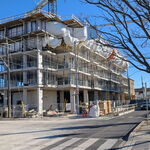Dan416
Senior Member
Riding transit in Poland the past couple weeks really reminded me how ridiculously closely spaced our stops here are. The trams and buses have subway-level spacing there.
Torontonians are a lazy bunch. Primarily I think it's because when they do the public consultations the majority of people who show up are seniors and they demand stops be close together. Our subway stops downtown are insanely close. The Bloor-Danforth line is especially ridiculous especially given the density around each station. It's the Toronto way to make transit as slow as possible. The TTC tries to take away stops and the residents complain loudly and put them back. I recall the St. Clair line study when I was in university. The original ROW that they were going to put in had about 1/3 less stops than the one currently running. The fact that we have a stop at St. Clair Station, then at Yonge, then another one a block away is ridiculous. The worst is between Vaughan and Spadina. There are 4 stops in a 300M area. Outside of the St. Clair W subway, the Tweedsmuir stop should be removed, as should be the Bathurst stop. Vaughan is close enough to Bathurst to not require a stop 50M to the east.
WHY DO YOU HATE OLD PEOPLE???
(Seriously, you should see the stop spacing discussions on the SELRT thread. You would think we were discussing a medivac shuttle for dismembered war soldiers, rather than light rail transit line.)
Making matters worse is the so-called "transit priority" traffic signs. (sic) With far-side stops, you'll think that the traffic signals would be timed (extended or quickened) to allow the streetcars (or buses) to get to the other side without stopping.
In other jurisdictions, they allow transit to proceed on their own without parallel greens, usually ahead of the left turning vehicles.
That's a major developement!Last year, the City re-wrote its signal timing guidelines, and changed their objective from "minimizing vehicular delay" to "minimizing person delay". This is partially due to changes in priorities, and partially due to advancements in delay estimation for non-auto modes.
WHY DO YOU HATE OLD PEOPLE???
(Seriously, you should see the stop spacing discussions on the SELRT thread. You would think we were discussing a medivac shuttle for dismembered war soldiers, rather than light rail transit line.)
Amazing! Maybe we'll finally see proper transit priority on Spadina, where it feels like streetcars spend 90% of their running time waiting for two cars to turn left before proceeding to the far-side stop.This is no longer true. Last year, the City re-wrote its signal timing guidelines, and changed their objective from "minimizing vehicular delay" to "minimizing person delay". This is partially due to changes in priorities, and partially due to advancements in delay estimation for non-auto modes.
Amazing! Maybe we'll finally see proper transit priority on Spadina, where it feels like streetcars spend 90% of their running time waiting for two cars to turn left before proceeding to the far-side stop.




